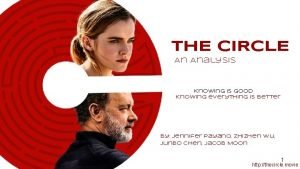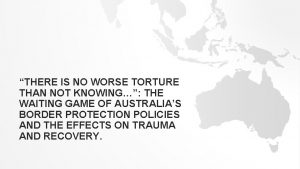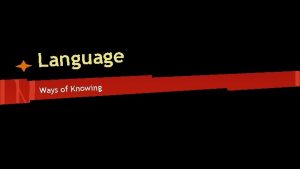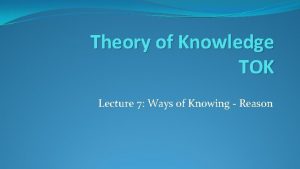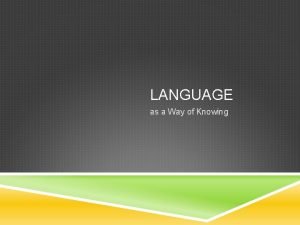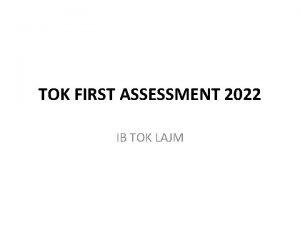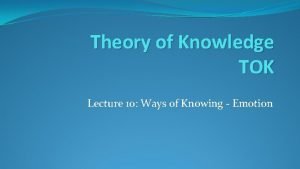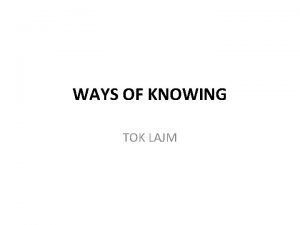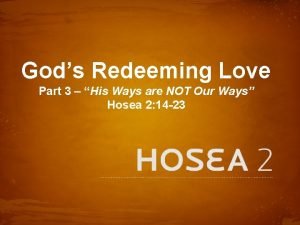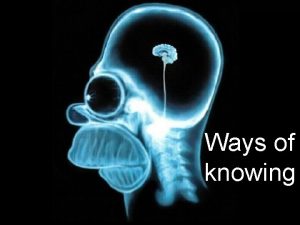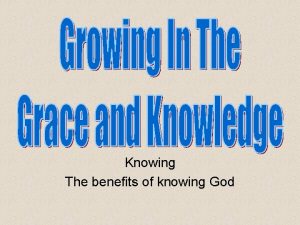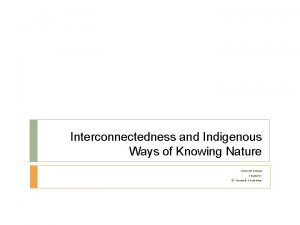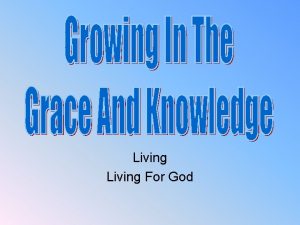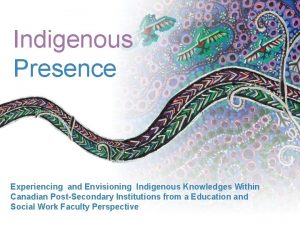IWOK Indigenous Ways of Knowing in Living Story











- Slides: 11

IWOK – Indigenous Ways of Knowing in Living Story Webs of Leadership & Society David M. Boje June 23 2018

IWOK – Indigenous Ways of Knowing in Living Story Webs of Relations to Family, Community, & Earth 1. 2. 3. 4. 5. 6. 7. 8. Relationships are the end in themselves Gifting is valued more highly Egalitarianism is preferred Non-acquisitiveness valued, not greed Usefulness or access to use is valued Barter is what is needed Trust and buyer trust valued Disclosure is full and voluntary 2

Living Story is Reflexivity Webwork Indigenous Ways of Knowing (IWOK) Living Story Web Paradigm Kaupapa Māori [Method + Theory in Praxis] “Each story is at once larger and smaller than itself, includes itself without including (or comprehending) itself, identifies with itself even as it remains utterly different…” (1979: 82). ; Derrida , treats story more in terms of their reflexivity web of story to other stories (99 -100). 9/6/2021 copyright STORI 3

LIVING STORY IS MULTIPLICITY OF VOICES Indigenous Ways of Knowing (IWOK) Living Story Web Paradigm Kaupapa Māori [Method + Theory in Praxis] Dialogical manner of story is “The plurality of independent and unmerged voices and consciousness and the genuine polyphony of full-valued voices” (Bakhtin, 1973: 4). Story and narrative are different: “Dialogic manner of the story” (1981: 60); “Narrative genres are always enclosed in a solid an unshakable monological framework” (1973: 13); In dialogism there is a move beyond “systematic monological philosophical finalizedness”

Qualitative-Multiplicity of our Living Stories Living Story is unfolding present, in a web of answerable spheres of relationship: family, work, community, friendship, education, & ecology without beginning or end, just in the middle (Boje, 2008, 2014, 2016) 5

Living Story Example before you begin “Grandpa John told me endless stories about young men who had opportunities to live up to their names. One day, he said, ‘there was a young man named Looks Twice--really, he was more like a boy---who left his village alone to hunt, hoping to bring back some meat. He wanted to prove that he was a man. It was in the springtime. He went without a bow or a lance, and he killed a deer with his knife. ’… ‘How did he kill the deer, Grandpa? ’ I interrupted. ‘You’d better figure that out, ’ he said. ‘That’s what will make you a man. ’” (Russell Means, in Fixico, p. 88, as cited in Rosile, 2016: 239). 6

What was he supposed to be looking at? CONTEXT: What does ‘runs like a deer’ mean? 1. How could LOOKS TWICE get close enough to kill a deer, if he is alone? 2. What kind of deer would be that slow? 3. In Spring, the rains flood the streams? 4. If one hunts with others, then there are more pairs of eyes to see 5. When something seems too good to be true… 6. If true, then is this INDIVIDUALISM the ways of TRIBAL COMMUNITY? 7. What are the sustainability long-term effects of this kind of hunting? 8. Many reasons why hunting alone is TABOO, a rule this young hunter broke • 9. When growing up others hear this story and by the time they are young adult, they know the CONTEXT of the living story lessons • • • 7

Indigenous Ways of Knowing (IWOK) Living Story Web Paradigm Kaupapa Māori [Method + Theory in Praxis] Two. Trees 1997 & 2000; Durie 2011; Rosile 2016, Pepion 2016; Cajete, 2000, 2008, & 2016; Grayshield 2016; Humphries, 2016; L. T. Smith 1999, 2008; G. H. Smith 2003; Tyler, 2011; Deloria & Wildcat 2001; Hoskins & Jones, 2017’ Paulo Friere's Pedagogy of the Oppressed Living stories have place, time, and ‘mind’ of aliveness; Living story is never alone, is always in the middle without beginning or end; and always points to another and yet another living story in the webwork of relationality of IWOK 8

EXERCISE 3: Indigenous Ways of Knowing (IWOK) Living Story Web Paradigm Kaupapa Māori [Method + Theory in Praxis] INSTRUCTIONS: 1. Write living story notes of your life in family, in relation to community, and if possible your connections to place, or moving from place to place 2. Pick is small problem or obstacle in that family/community and make notes on transformative PRAXIS that you could do within your family/community/ecology 3. Pair off and share your living story TERSELY, what they other would know if they had been there, in the know about CONTEXT, SITUATION. See how your partner is able to ask you about the CONTEXT, and comes to UNDSTAND YOUR GROUND and your Story-Theory, and your PRAXIS. Be sure to follow the 5 I’s from Rosile (2016: 967) • Kaupapa Māori, Friere's Pedagogy of the oppressed, and some Participative Action Research (PAR) put storytelling method/theory into PRAXIS of liberation from oppressions • PRAXIS means THEORY+METHOD in ACTION, a transformational change/liberation from oppression, injustice, in order for family and/or community to bring about new way of Being-in-the-world together so LOOKS TWICE has lessons for the Elders and Parents to teach the young, growing up, so they don’t hunt alone, and destroy the herd the sustains the tribe. 1. INDIRECT Give a ‘story-stem’ and ask partner to complete the story, what do you imagine happened next? 2. INCLUSIVE – Include non-human characters in your story They send meta message about Natural world 3. INCOMPLE – Tell it terse so the partner fills in the blanks with taken-for-granted assumptions 4. IN CONTEXT – Partner needs to explore the context of the story to discover learning principles/lessons 5. INQUIRING – Story-teller, ask partner ‘what is the moral of this story’ rather than just telling it. 9

Debrief Living Story Conversations LIST ADVANTAGES 1. 2. 3. 4. LIST DISADVANTAGES 1. 2. 3. 4. 10

Antenarrative Process Paradigm is Betwixt & Between IWOK Living Story Webs & WWOK Dominant Narrative. Counternarrative 11
